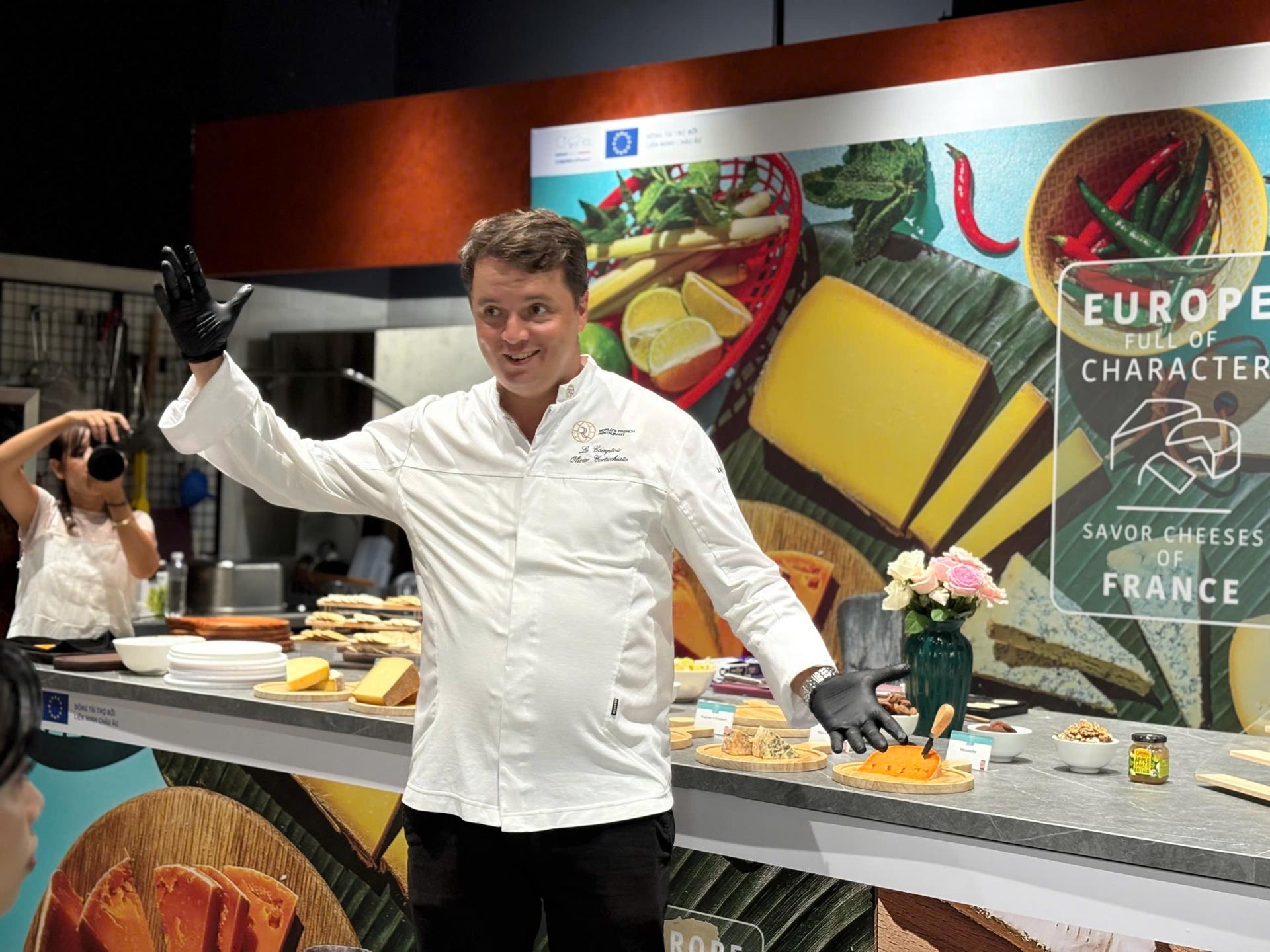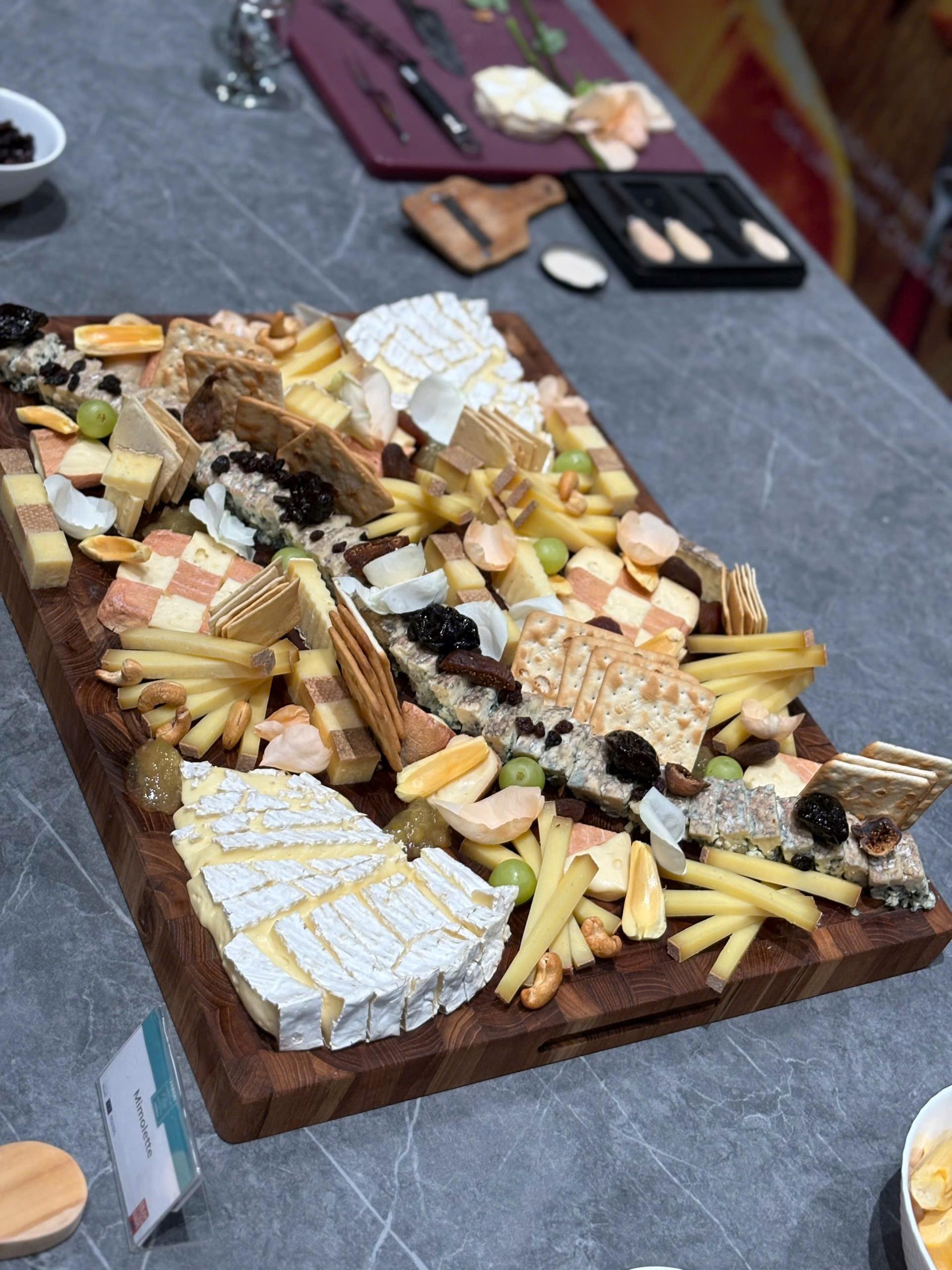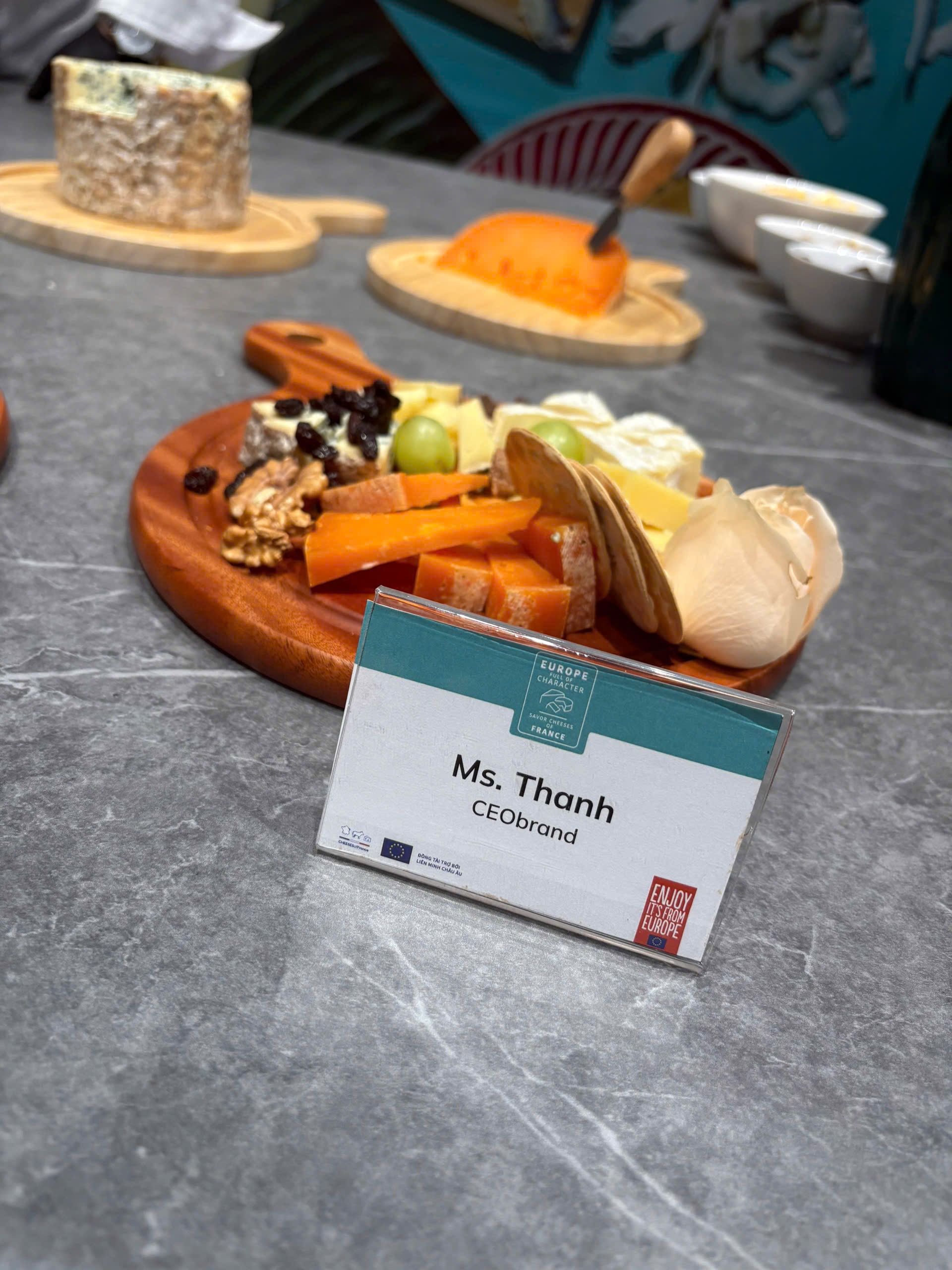On the afternoon of 2 October 2025, at Tastemaker Hub in Phu My Hung, Ho Chi Minh City, French chef Olivier Corti – owner of Le Comptoir in Da Nang – flew in to host a workshop that brought the world of French cheese to life. With five “families” of cheese likened to the five fingers of a hand, and the “palm” as the meeting point of flavours, participants discovered a map of taste both vivid and memorable.
 Chef Olivier Corti is introducing the history and culture of French cheese. (Kim Thanh)
Chef Olivier Corti is introducing the history and culture of French cheese. (Kim Thanh)
On 2 October, Tastemaker Hub transformed into a “classroom of flavours” as Olivier Corti recounted stories of cheese as though recalling an old friend. He began with a playful comparison: the taste of cheese in France is as layered and regional as Vietnam’s fish sauce – both hold centuries of history and countless variations depending on locality. From the Middle Ages, French monasteries cultivated and preserved recipes, spreading them across valleys, mountains and coastal lands. The differences in soil and climate – what the French call terroir – gave each region its own cheese personality, producing today a dazzling wealth of varieties.
Corti summed up the world of French cheese into five “great families” – a vivid way to imagine them as the five fingers of a hand. In the “palm” rests the memory of fresh cheese: soft, moist, mild, consumed almost immediately after production. On the thumb sit the soft cheeses with bloomy rinds, such as Brie or Camembert, cloaked in their white velvet coats of Penicillium mould. The second finger holds the semi-hard cheeses, pressed to remove moisture but still supple, creamy and sliceable, such as Tomme de Savoie or Morbier. The third finger represents the hard, pressed cheeses – matured longer, dense in texture and complex in flavour – Comté, Emmental, Mimolette. The fourth belongs to the washed-rind cheeses, with orange or reddish skins, pungent aromas from regular washing in brine or spirits – Munster, Époisses. Finally, the little finger bears the blue cheeses, veined with Penicillium roqueforti, salty, bold, and aromatic – Roquefort, Bleu d’Auvergne. Thanks to Corti’s rich metaphors, even newcomers found themselves holding a “map” of this world without losing their way.
 A cheeseboard for 10 guests prepared by Chef Olivier Corti at the workshop. (Kim Thanh)
A cheeseboard for 10 guests prepared by Chef Olivier Corti at the workshop. (Kim Thanh)
The tasting then turned to what Corti called the “personality study” of cheese. Brie is seductive and refined; its white rind like a silk gown, its paste buttery, creamy, with hints of fresh mushroom. Mimolette is mysterious and unique, its burnt orange flesh reminiscent of the moon, dense and nutty with a whisper of caramel. Bleu d’Auvergne is bold and brave, salty, spicy, leaving a powerful aftertaste. Emmental is cheerful and engaging, its signature holes like open laughter, its flavour milky and nutty, always approachable. Comté is patient and trustworthy – the longer it matures, the more it reveals layers of almond, dried grass, and ripe fruit. Through such characterisations, participants could easily find the “friend” that suited their taste.
Pairing with wine was the workshop’s most memorable highlight. Brie, Corti suggested, shines with Champagne or Chardonnay, the bubbles and acidity lifting its creaminess into elegance. Mimolette couples with Bordeaux or a Rhône Syrah, where tannins frame its firmness and depth. Bleu d’Auvergne blossoms alongside a sweet Sauternes or late harvest wine: salt and sweetness converse, while spice is softened by notes of honey, peach and apricot. Emmental plays happily with a Sauvignon Blanc or young Riesling, their crisp acidity brightening its milk and nut tones. Comté remains faithful to a delicate Pinot Noir or a white wine from Jura – even Vin Jaune for the adventurous – where umami and nuttiness find companionship in red fruit and almonds. The rule of thumb: soft and delicate cheeses love white wine or Champagne; strong and salty ones marry with sweet wine; firm and nutty cheeses are best with light reds or structured whites. Above all, Corti warned, never pair heavy tannic reds indiscriminately – they crush the subtleties of cheese.
Beyond wine, the workshop ventured into condiments – fruit, nuts, jams. The principle: balance, not dominance. Blue cheese thrives with wild honey, pear or fig preserves, the fruit sugar tempering salt and spice. Brie finds harmony with woodland berry compote or apricot jam with gentle acidity. Emmental is easy-going: baked apples with cinnamon, grape jelly – all agreeable. Comté pairs beautifully with onion chutney, fig or dried apricot, while Mimolette dances with quince paste (pâte de coing). Overly sugary, artificial jams or strong flavourings, however, overwhelm and flatten the cheese. If sweetness goes astray, rescue comes with a slice of fresh apple or a sip of crisp white wine.
Presentation was another French ritual Corti underlined. A cheeseboard should always feature an odd number – 3, 5, or 7 – to give rhythm to both eye and palate, avoiding dull symmetry. Arrangement may follow a clockwise path, from mild to strong, from soft to firm, with each cut preserving rind, body and core to balance flavour. Some prefer to centre a powerful cheese, with milder ones fanning outward. Storage too demands care: cheese should be wrapped in waxy paper with a thin film, kept in the vegetable drawer at 3–5°C. For serving, remove 30–45 minutes beforehand, accompany with thin slices of baguette or country bread, avoid sweet biscuits. A handful of walnuts, almonds, seasonal fruit and a small bowl of honey complete the stage for taste to perform.
Corti also revealed a glimpse of the backstage craft: milk choice – cow, goat, sheep – sets the foundation. Fermentation and rennet curdle the milk, curd is cut, stirred, heated or pressed to fix texture, then the magic of ageing begins. White rinds are nurtured by friendly moulds, washed rinds by ritual cleansing, blue cheeses by veins of mould and deliberate airflow, hard cheeses by patience itself. By the end of the afternoon, each participant left with a framework to decode labels and shop confidently for their own cheeseboard.
 The author’s cheeseboard at the 2 October workshop at Tastemaker Hub (Phu My Hung, Ho Chi Minh City).
The author’s cheeseboard at the 2 October workshop at Tastemaker Hub (Phu My Hung, Ho Chi Minh City).
What was striking was how the universe of French cheese suddenly felt within reach in Saigon. A chef who runs Le Comptoir in Da Nang flying in to teach meant that recipes and stories stepped out of a single restaurant to meet a community of food lovers. The spirit of France was not only in wine and cheese, but also in slowing down: to look, smell, touch, taste, and remember – just as Corti’s “palate in your hand” metaphor suggested.
As the sun set over Phu My Hung, slices of Brie, Emmental or Bleu d’Auvergne on the final board closed a fulfilling workshop. Attendees left with a few pairings “in the palm of the hand”: Brie–Champagne to begin, Comté–Pinot Noir to linger, Blue–Sauternes to conclude. Alongside came one simple reminder about cheeseboards: always choose odd numbers, arrange by flavour, and let fruit, jam and wine elevate, not overpower. From a few hours on a Saigon afternoon, the map of French cheese now rests quite literally in the palm of the hand.
CHÚNG TÔI LÀ NHỮNG GÌ BẠN CẦN! ĐỘI NGŨ CHUYÊN NGHIỆP CỦA CHÚNG TÔI SẼ ĐẢM BẢO BẠN CÓ ĐƯỢC SỰ GIÚP ĐỠ CAO NHẤT.